Painters Chamber portrait
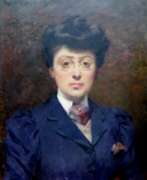

Louise Abbéma was a French painter, sculptor, and designer, celebrated for her work during the Belle Époque. Born in Étampes in 1853 into an affluent Parisian family, she became well known for her portraits, particularly of the famous actress Sarah Bernhardt, and for decorative panels commissioned for various public buildings in Paris and the Palace of the Governor in Dakar, Senegal.
Abbéma's art often depicted the upper echelons of French society and reflected the Impressionist style through her light and rapid brushstrokes. She was also notable for her involvement in the women's movement, where she contributed to the emerging image of the 'New Woman' by portraying androgynous figures and themes of intellectualism and freedom.
Among her many honors, Abbéma was awarded the Palme Academiques in 1887, nominated as the Official Painter of the Third Republic, and in 1906, she became a Chevalier of the Legion of Honour. Her works, such as "Lunch in the Greenhouse" and "Portrait of Sarah Bernhardt," have seen a resurgence in popularity as the contribution of women to historical art gains more recognition.
For those interested in the evocative and historically rich artworks of Louise Abbéma, consider subscribing to our updates. We'll keep you informed about new sales, auctions, and exhibitions featuring Abbéma's work, ensuring you're always connected to the latest offerings in the art and antique collectors' sphere.
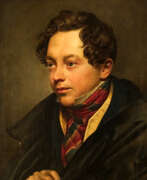

Pyotr Vasilievich Basin (Russian: Пётр Васильевич Басин) was a Russian painter, born in 1793 and passed away in 1877, renowned for his large-scale religious, historical, and portrait artworks. A distinguished member of the Imperial Academy of Arts in Saint Petersburg, Basin's career was marked by a significant period in Rome, where he studied under a fellowship and produced nearly a hundred paintings.
Basin's artistic legacy includes notable works such as the allegorical figures for the Winter Palace and several religious scenes for the Saint Isaac's Cathedral and Kazan Cathedral. His contributions extend to teaching roles at the Imperial Academy, where he influenced future generations until his retirement due to a progressive eye disease.
Basin's works are prominently displayed in the Russian Museum among other locations, serving as a testament to his skill and dedication to the arts. For collectors and enthusiasts looking to explore more about Basin's works or receive updates on sales and auctions featuring his art, signing up for specialized newsletters can provide timely and exclusive information.


Karl Hampeln (Russian: Карл Карлович Гампельн) was a 19th-century Russian artist of German (Austrian) origin. He is known as a draftsman, watercolorist, etcher, and lithographer.
He is best known for his engravings of biblical themes and his panoramic views of the festivities in Ekateringhof with the participation of Emperor Alexander I. The artist's lithographs with equestrian portraits of the Russian emperor and members of the imperial family have also survived.
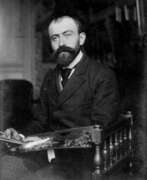

Aleksei Alekseevich Kharlamov (russian: Алексей Алексеевич Харламов) was a Russian artist renowned for his portrait paintings. Born in 1840 in Saratov, Russia, Kharlamov displayed artistic talent from an early age, eventually studying under the guidance of Professor A. T. Markov at the Imperial Academy of Arts. His dedication to art was rewarded with several medals during his academic years, and his piece titled "Baptism of Kiev" earned him a prestigious gold medal in 1866.
Kharlamov spent much of his career in Paris, where he was deeply influenced by Western European artistic movements. His works often featured delicate and finely detailed representations of women and children, capturing the subtleties of expression and mood which became his signature style. Notably, his painting "Young Woman and Child" from 1894 showcases his adept use of light and texture to portray serene domestic scenes, a piece that is currently held in the Bowdoin College Museum of Art.
Throughout his career, Kharlamov was associated with prominent cultural figures such as the novelist Ivan Turgenev, and he participated actively in the Parisian art scene. His portraits were highly sought after, with clients paying substantial sums for his works, reflecting his status as a distinguished portraitist of his time.
For those interested in exploring the works of Aleksei Alekseevich Kharlamov and the rich cultural tapestry of his era, signing up for updates on auctions and events featuring his art can provide valuable insights and opportunities to acquire pieces by this notable artist. Stay informed about the latest sales and exhibitions by subscribing to our newsletter dedicated to Kharlamov’s legacy.
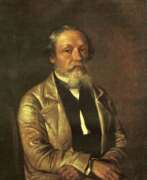

Ivan Fomich Khrutsky (Russian: Иван Фомич Хруцкий) was a Belarusian painter known for his exceptional still-life paintings and portraits. Born in 1810, Khrutsky gained recognition for his detailed and vibrant depictions of flowers, fruits, and everyday objects, showcasing his mastery in capturing light and texture.
Khrutsky's work stands out due to its meticulous attention to detail and rich color palette, which brought a lifelike quality to his paintings. His ability to convey the delicate interplay of light and shadow made his still lifes particularly admired among art collectors and connoisseurs. Aside from still lifes, he also painted portraits, landscapes, and genre scenes, contributing to his versatile artistic repertoire.
One of Khrutsky's notable works, "Flowers and Fruits," exemplifies his skill in creating compositions that are both aesthetically pleasing and technically superb. His paintings are featured in various museums, including the Tretyakov Gallery in Moscow, where art enthusiasts can appreciate his contribution to the world of art.
For those interested in exploring more about Ivan Fomich Khrutsky and staying updated on related auctions and sales, sign up for updates. You'll receive notifications about new product sales and auction events related to this distinguished artist.
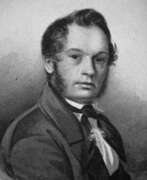

Evgraf Fedorovich Krendovsky (Russian: Евграф Фёдорович Крендовский) was a Russian artist born in 1810 in Kremenchuk, now part of Ukraine, renowned for his work in portrait, genre, and interior painting. Initially engaged in police work in Arzamas, Krendovsky shifted his focus to art, studying under the guidance of Alexey Venetsianov in St. Petersburg from 1830 to 1835. Despite a promising start, family circumstances forced him to return to Kremenchuk, where he became a drawing tutor and later achieved the status of "Free Artist" by the Imperial Academy of Arts.
Krendovsky's career is marked by a relatively small body of work, with just over twenty known paintings to his name. Some of his most celebrated pieces include portraits and scenes depicting the daily life of Russian society, which now grace collections such as the Tretyakov Gallery in Moscow and the Russian Museum in St. Petersburg. His notable works include "Portrait of an Unknown Woman in a Violet Dress" and "The Artist’s Daughters" from 1845.
For art enthusiasts and collectors interested in 19th-century Russian art, Krendovsky remains a figure of fascination due to his unique style and the historical context of his works. To stay updated on upcoming sales and auction events featuring Krendovsky's works, sign up for updates at [Link to subscription page]. This subscription will keep you informed about new opportunities to acquire pieces by this distinctive artist.
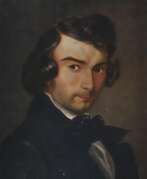

Apollon Nikolaevich Mokritsky (Russian: Аполлон Николаевич Мокрицкий) was a Ukrainian-Russian painter and art educator, known for his contributions to the 19th-century art scene. Born in 1810 in Pyryatyn, Ukraine, Mokritsky became an influential figure in Russian academic art, specializing in portrait and historical painting.
Mokritsky's work is celebrated for its detailed realism and emotional depth. His portraits often capture the essence of his subjects, showcasing his skill in rendering lifelike expressions and intricate details. One of his most notable works is the portrait of the renowned Russian poet, Taras Shevchenko, which exemplifies his ability to combine technical precision with profound sensitivity.
In addition to his painting, Mokritsky played a significant role as an educator. He taught at the Moscow School of Painting, Sculpture and Architecture, where he mentored many young artists who would go on to shape Russian art. His influence extended beyond his own works, helping to cultivate a new generation of artists.
Today, Mokritsky's paintings can be found in various museums and galleries, including the Tretyakov Gallery in Moscow. His contributions to art and education continue to be recognized and celebrated by art collectors and historians alike.
Sign up for updates to learn more about new product sales and auction events related to Apollon Nikolaevich Mokritsky.
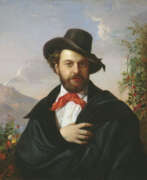

Pimen Nikitich Orlov (Russian: Пи́мен Ники́тич Орлóв) was a Russian painter renowned for his mastery in the Classical style, celebrated for his artistry across various genres throughout his predominant career in Italy. Born into a miller's family in 1812 near Malo-Foshchevaty, Orlov displayed an early aptitude for drawing, despite the financial challenges that initially hindered his artistic education. His persistence led him to apprentice under a traveling decorative painter, ultimately facilitating his formal studies at the Imperial Academy of Arts under the guidance of Karl Bryullov.
Orlov's works are distinguished by their delicate color treatment and effective lighting, capturing the essence of his subjects with a thorough finish. His portfolio predominantly features portraits and genre scenes reflective of Italian life, though he also ventured into historical subjects and landscapes. Notable works include "Young Roman Girl at the Fountain" and "Italian Morning," both of which were acquired by Emperor Nicholas I, underscoring the demand for his art in Russia.
Many of Orlov's paintings are housed in prestigious collections across Russia and the CIS, including the Tretyakov Gallery and the Tver Regional Picture Gallery, among others. His legacy continues to be celebrated, affirming his status as a significant figure in 19th-century Russian art.
For those interested in exploring the works of Pimen Nikitich Orlov or staying updated on sales and auction events featuring his art, signing up for our newsletter provides an excellent opportunity to connect with this classical master's enduring appeal.
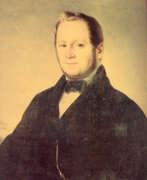

Eugène Pluchart (Russian: Евгений Александрович Плюшар) was a Russian painter and photographer of French descent, born in 1809 in Saint Petersburg and passed away around 1880 in Dresden. Initially trained at the Beaux-Arts de Paris under Louis Hersent, he further honed his skills at the Academy of Fine Arts in Munich. Pluchart's artistry blossomed during a study trip to Italy, which significantly influenced his style.
Pluchart is renowned for his portrait work and frescoes, notably contributing to the décor at Saint Isaac's Cathedral during the 1840s. His mastery in capturing the essence of his subjects is evident in his portraits of notable figures such as the composer Karol Lipiński, which earned him the title of full Academician by the Imperial Academy of Arts. His works also include a notable portrait of the composer that further solidified his reputation.
After a prolific period in Russia, Pluchart moved to Dresden in the early 1860s. His later years were quieter, with his contributions to the arts remaining influential, particularly in Russia and Germany. His works are part of the collection in prominent institutions like the Hermitage Museum and the Alte Nationalgalerie.
For those interested in the works and life of Eugène Pluchart and future auction events related to his art, consider subscribing to updates [insert link here]. This subscription will keep you informed about new product sales and auction events specifically related to Eugène Pluchart, ensuring you stay connected to the latest offerings in his artistic legacy.
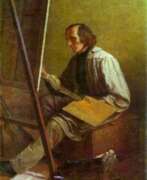

Fyodor Mikhailovich Slavyansky (Russian: Фёдор Михайлович Славянский) was a distinguished Russian painter, known for his remarkable journey from serfdom to academician. Born around 1817 in Vyshkovo, Tver Guberniya, he initially lived as a serf under landlady Avdotya Nikolayevna Semenova. His artistic talent was nurtured by Alexei Venetsianov, who not only mentored him but also purchased his freedom.
Slavyansky's education at the Imperial Academy of Arts began in 1840, where he excelled in drawing under the tutelage of professors Varnek and Markov. By 1845, he was recognized as a freelance artist, and later his portraits, especially of notable personalities, gained him considerable acclaim. His works include "Portrait of V.K. Shebuev" and "Peasant's Girl," both of which demonstrate his skill in capturing the essence of his subjects.
Today, Slavyansky's works are preserved in several prestigious collections, including The Russian Museum in St. Petersburg. His life and art continue to inspire, illustrating a profound narrative of artistic dedication and transformation within 19th-century Russian society .
For updates on exhibitions and sales related to Fyodor Mikhailovich Slavyansky, sign up here. Stay informed about the legacy of this eminent artist and opportunities to appreciate his works firsthand.


Pyotr Fyodorovich Sokolov (Russian: Пётр Фёдорович Сóколов) was a Russian artist, prominent for his mastery in aquarelle portrait painting during the Pushkin era. Born in Moscow in 1787, Sokolov was a trailblazer in Russian watercolor portraiture, a technique he refined to capture the essence and subtleties of his subjects with notable delicacy and expressive linearity. His education at the Imperial Academy of Arts laid the groundwork for his artistic career, where he developed his unique style that resonated throughout his prolific output of over 500 works.
Sokolov's portraits are cherished for their historical and artistic value, depicting many key figures of his time including the likes of Alexander Pushkin. His innovative use of watercolor, often enhancing his pieces with graphite for depth, set a new standard in Russian art, moving away from the heavier oil paints and traditional techniques used by his contemporaries. His works are now housed in prestigious institutions like the State Russian Museum and the Tretyakov Gallery, ensuring his legacy persists.
For enthusiasts and collectors, keeping abreast of exhibitions and auctions featuring Sokolov’s works is essential. Sign up for updates related to Pyotr Fyodorovich Sokolov to stay informed about new discoveries and sales of his art. This subscription service focuses exclusively on bringing you news from the art world that pertains directly to Sokolov’s enduring legacy.
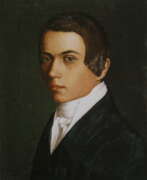

Grigory Vasilyevich Soroka, née Vasiliev (Russian: Григорий Васильевич Сорока) was a Russian painter, known for his mastery in realistic portraits and landscapes that beautifully captured the essence of 19th-century Russia. His artistic journey began under the guidance of his teacher, Alexei Venetsianov, a prominent figure in the Russian art scene. Soroka’s works are remarkable for their attention to detail, vivid portrayal of peasant life, and sensitive handling of light and shadow, distinguishing him from his contemporaries.
His most notable works include "The Peasant Girls Gathering Brushwood" and "Self-Portrait," both exemplifying his skill in using light to express depth and emotion. These paintings are celebrated for their historical and cultural significance, providing a window into the rural life of Russia during that period. Despite his untimely and tragic end, Soroka’s contributions to Russian art have not been forgotten, with several of his works displayed in prestigious galleries, including the Russian Museum in St. Petersburg.
For art collectors and experts, Soroka’s pieces represent a valuable connection to Russian heritage and the realism movement. If you wish to stay informed about upcoming sales and auction events featuring works by Grigory Vasilyevich Soroka, consider signing up for updates. This subscription will ensure you are promptly alerted to new opportunities to acquire pieces by this distinguished artist.
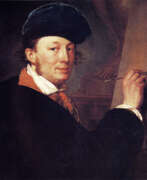

Alexander Gregoryevich Varnek (Russian: Александр Григорьевич Варнек) was a distinguished Russian painter. Known primarily for his portraits, Alexander Varnek captured the essence of figures in Russian society with a finesse that made him a notable artist of his time. He was a student under the guidance of Dmitry Levitzky and Stepan Shchukin at the Imperial Academy of Arts, where he later returned as a professor and advisor.
Alexander Varnek's artistry was celebrated for its masterful drawing, harmonious coloring, and the ability to capture close resemblances and appropriate lighting in his portraits. His conscientious execution and avoidance of embellishment in his works earned him high regard among contemporaries. Some of his notable works include portraits of Madame Khatova, Count Alexander Stroganov, and Alexey Olenin, along with other subjects like "Head of a Young Turk" and "Boy with Dog".
His life was intrinsically linked to St. Petersburg and the Imperial Academy of Arts, reflecting a career that spanned teaching, creating, and contributing significantly to Russian art. Alexander Varnek's journey included a period spent abroad in Rome, where he further honed his craft, leaving behind a legacy encapsulated in his portraits and other artworks that continue to be celebrated in the world of art.
For collectors and experts in art and antiques, Alexander Grigorievich Varnek's body of work offers a glimpse into the rich tapestry of Russian portraiture and its evolution during his lifetime. To delve deeper into his life and explore his creations, consider signing up for updates related to Varnek and stay informed about exhibitions, sales, and auctions of his works.
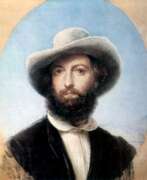

Otto Friedrich Theodor Möller (Russian: Фёдор Антонович Моллер), a Russian academic painter of Baltic-German descent, was renowned for his detailed and expressive portraits, figure paintings, and genre scenes. Born in 1812 in Kronstadt, Saint Petersburg, Möller was deeply influenced by his mentor, Karl Briullov, at the Imperial Academy of Fine Arts. His journey as an artist was marked by a successful tenure in Italy, where he embraced the vibrant local culture and further honed his skills, particularly in portraying everyday Italian life and historical narratives .
Möller's artworks are celebrated for their clarity of composition and expressive color palette, traits he mastered under Briullov's guidance. His notable works, like the portrait of Nikolai Gogol, are admired for their lifelike representation and emotional depth. These paintings not only showcase his technical skill but also his ability to capture the subtle nuances of his subjects' personalities.
Möller's contributions to Russian art extend beyond his paintings. He was a professor and a significant figure at the Imperial Society for the Encouragement of the Arts, dedicating much of his later years to teaching and supporting fellow artists. His works are held in high esteem and continue to be featured in major Russian museums, including the Tretyakov Gallery and the Russian Museum.
For collectors and enthusiasts wishing to stay updated on exhibitions and auction events featuring Otto Friedrich Theodor Möller's works, signing up for newsletters and alerts from relevant art institutions can be highly beneficial. This ensures that you remain informed about opportunities to view or purchase his esteemed works.


Carl Timoleon von Neff (Russian: Тимофей Андреевич Нефф) was a Baltic German painter, known for his mastery in religious, portrait, and allegorical themes. Born in 1804 in Püssi, Estonia, Neff's talent led him to study under renowned artists in Italy and Germany, honing a style that blended academic and neoclassical influences.
Neff's works are particularly revered for their delicate handling of religious subjects and the regal elegance of his portraits. He became a favored artist at the Russian court, contributing significantly to the art collection of the Imperial family. Among his notable works, the altarpieces in the palace church at Peterhof and the St. Michael's Castle in Saint Petersburg stand out, showcasing his skill in creating spiritually profound and aesthetically pleasing compositions.
For art collectors and experts, Neff's paintings not only represent a fusion of religious devotion and artistic finesse but are also a testament to the rich cultural interplay in 19th-century Russian art. Those interested in exploring or acquiring pieces by Carl Timoleon von Neff should consider signing up for updates on new sales and auction events specifically related to his works. This ensures you remain informed about the availability of his influential and sought-after pieces.
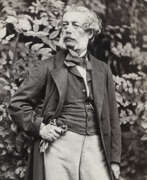

Franz Xaver Winterhalter was a renowned German painter and lithographer, celebrated for his masterful portraits of the nineteenth-century European aristocracy. Born in 1805 in a small village in the Black Forest, Winterhalter rose from humble beginnings to become the favored portraitist at royal courts across Europe, including those of Britain, France, and Russia.
Winterhalter's artistry is especially noted for its blend of realism and idealization, which made his portraits highly sought after by the elites of the time. His work is characterized by a delicate yet expressive handling of detail and a sophisticated use of color to enhance the opulence of his subjects' attire and surroundings. One of his most famous works, "The Empress Eugénie Surrounded by her Ladies in Waiting," epitomizes his style and skill in capturing the elegance and grace of the imperial courts.
His works are held in esteemed public collections worldwide, including the National Gallery of Art and the J. Paul Getty Museum, which preserve and display several of his important portraits. Winterhalter's legacy endures, and his paintings continue to be celebrated for their historical significance and artistic merit.
For those interested in exploring more about Franz Xaver Winterhalter's life and works, consider subscribing for updates related to new product sales and auction events featuring his art. This subscription is an excellent resource for collectors and experts in art and antiques, ensuring you stay informed about opportunities to acquire pieces by this illustrious artist.


Nikolai Alexandrovich Yaroshenko (Russian: Николай Александрович Ярошенко) was a prominent Russian painter of Ukrainian origin, recognized for his profound contributions to genre and portrait painting, particularly focusing on societal themes and the daily struggles of working people. Born on December 13, 1846, in Poltava, then part of the Russian Empire, Yaroshenko initially pursued a military career before devoting himself to art.
Yaroshenko became an influential member of the Peredvizhniki, a group of Russian realist artists who sought to portray real life with a moral or social message. His works are notable for their depth of emotion and social commentary, highlighting the lives of the common folk and the societal challenges of the time. Among his well-known paintings are "The Stoker" and "The Prisoner," both of which reflect his concern for the plight of the oppressed and showcase his skill in evoking empathy through art.
Many of Yaroshenko's masterpieces are housed in prominent Russian museums, such as the Tretyakov Gallery, reinforcing his status in the annals of art history. His works continue to resonate, providing insight into the social dynamics of 19th-century Russia and the struggles therein.
For art collectors and experts interested in the poignant realism and historical depth of Yaroshenko's paintings, staying updated on exhibitions and auctions featuring his work can be incredibly rewarding. To receive alerts about new sales and auction events related to Nikolai Alexandrovich Yaroshenko, consider signing up for updates through specialized art platforms.
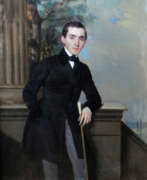

Pyotr Zakharovich Zakharov-Chechenets (Russian: Пётр Захарович Захаров-Чеченец), a Russian painter of Chechen origin, was a notable artistic figure in the 19th century. Born in 1816, he was adopted by Major-General Pyotr Yermolov and showed early talent in painting, which led him to the Imperial Academy of Arts in Saint Petersburg. Despite facing significant obstacles, including racial discrimination that barred him from receiving a scholarship to study in Italy, Zakharov excelled at the Academy and graduated in 1835 with a diploma of Free Artist.
Zakharov became a prominent portraitist, attracting the patronage of significant figures, including the favorite daughter of Nicholas I, Grand Duchess Maria Nikolayevna. His works, known for their expression and depth, include notable portraits such as that of Aleksey Petrovich Yermolov in 1842, which earned him membership in the Academy of Arts. His pieces were highly regarded and are held in prestigious collections, including the Tretyakov Gallery and the Russian Museum.
Tragically, Zakharov's life was cut short by tuberculosis, passing away in 1846 shortly after his marriage. His legacy, however, continues to be celebrated, with his art significantly featured in collections and studies concerning Russian artists of his era. His work not only highlights his artistic skill but also serves as a testament to his resilience against the societal challenges of his time.
For those interested in the profound work and enduring influence of Pyotr Zakharov-Chechenets, updates on exhibitions and sales can be subscribed to, ensuring enthusiasts and collectors stay informed on available works and new discoveries related to this distinguished artist.


Sergey Konstantinovich Zaryanko (Russian: Сергей Константинович Зарянко) was a distinguished Russian portrait painter and art educator of Belarusian descent, renowned for his exceptional ability to capture the essence of his subjects with striking realism and meticulous detail. Born on September 24, 1818, in the village of Lyady in the Mogilyov Province, Zaryanko was originally the son of a serf. His early exposure to art came after his family gained freedom and moved to Saint Petersburg, where he began informal studies at the Imperial Academy of Arts in 1834 under the mentorship of Alexey Venetsianov.
Zaryanko's career flourished after he achieved the status of Academician in 1843 and subsequently became a professor at the Moscow School of Painting, Sculpture, and Architecture. His works are notable for their vivid portrayal of characters and the use of light and shadow to enhance the textural qualities of materials like velvet and satin. Among his famous works are portraits of Fyodor Tolstoy and Natalia Sergeyevna Zaryanko, his daughter, which reflect his skill in portraying personal and emotive qualities.
His contributions extended beyond painting to include significant theoretical works on art and teaching methods. Despite the changing artistic trends towards critical realism in the late 19th century, Zaryanko remained faithful to his classical style, which eventually led to a decline in his popularity before his death on December 20, 1870, in Moscow.
If you're captivated by the artistry and historical significance of Sergey Konstantinovich Zaryanko's works, consider signing up for updates from leading art galleries and auction houses. Stay informed about upcoming exhibitions and exclusive sales opportunities that feature Zaryanko's masterpieces. Subscribe today to ensure you never miss an event or the chance to acquire a piece of art history.